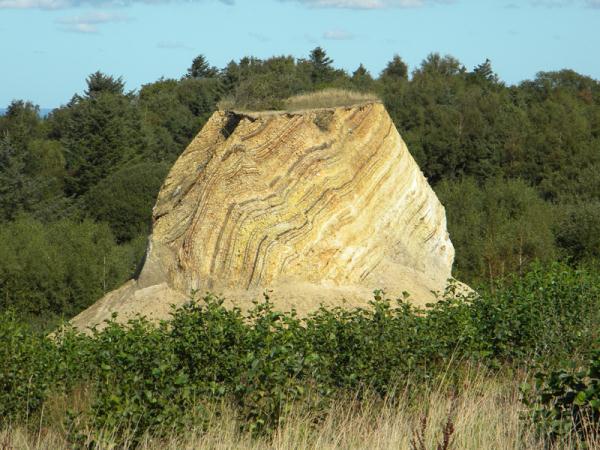DANSK:
Moleret på øen Fur blev aflejret på bunden af det hav, der
dækkede området for ca. 55 millioner år siden. Det består
hovedsagligt af kiselalger, men der er også gode chancer for at
finde fossile fisk, insekter, krybdyr og planter. I moleret er der
også ca. 200 askelag, der dalede ned over Europa efter vulkanudbud
der opstod, dengang Den Midtatlantiske Ryg begyndte at åbne sig og
Atlanterhavet blev dannet. Disse askelag ses som tydelige mørke
striber i det ellers lyse moler. Derfor kaldes moleret også
"Nordatlantens fødselsattest". Atlanterhavet vokser fortsat med ca.
25 mm om året i gennemsnit ved Den Midtatlantiske Ryg, og der er
derfor stadigvæk vulkanudbrud i Atlanterhavet og på Island, der
også vokser i takt med Atlanterhavet.
Moleret på Fur er et meget yndet sted for fossiljægere, men
geocachere og andre kan også nyde den unikke natur på stedet.
|

|
Det er livsfarligt at
færdes tæt på de stejle skrænter, da de kan styrte sammen uden
varsel.
Tænk dig om, og respekter advarselstavlerne i
området.
|

|
Sådan logger du denne
EarthCache:
- "Hvor mange af de ca. 200 askelag er officielt blevet
nummereret?" Svaret, der findes på infotavler i området,
sendes til mig via "Send
Message" på
profil-siden.
Du behøver ikke at afvente svar fra mig, men kan straks gå videre
til logning. Hvis du undlader at sende svaret, eller hvis tallet i
svaret er forkert, kan din logning dog blive slettet uden varsel
(normalt vil jeg dog først give dig en chance for at rette
fejlen).
- Log dit besøg uden at skrive svaret i loggen. Du er velkommen
til at vedhæfte et foto af dig selv og din GPS foran en moler-klint
eller Bispehuen (på sikker afstand), men det er ikke et krav for at
logge cachen som fundet.

Moler med mørke askelag

Bispehuen
ENGLISH:
The moler sediments on the island of Fur were deposited at the
bottom of the sea that covered the area approx. 55 million years
ago. It is composed mainly of diatoms, but there is also a good
chance of finding fossil fish, insects, reptiles and plants. In
moler is also approx. 200 ash layers that descended over Europe
after the volcanic eruptions that occurred when the Mid-Atlantic
Ridge began to open up and the Atlantic Ocean was formed. These
layer of ash is seen as distinct dark stripes in the otherwise
bright moler. Therefore moler is also called "The North Atlantic
birth certificate". Atlantic continues to grow by approx. 25 mm
annually at the Mid-Atlantic Ridge, and thats why there is still
volcanic eruptions in the Atlantic and in Iceland, which also grows
as the Atlantic Ocean.
Moler on Fur is a very popular location for fossil hunters, but
geocachers and others can also enjoy the unique nature in the
area.
|

|
It is dangerous to move
close to the steep slopes as they may collapse without
warning.
Use common sense and respect the warning signs in the
area.
|

|
How to log this EarthCache:
- "How many of the approx. 200 ash have been officially
numbered?" Send the answer, available on information boards
in the area, to me via the "Send
Message" on the
profile page.
You do not have to wait for my reply, but can immediately proceed
to logging. However, if you fail to send the answer, or if the
number in the answer is wrong, your log may be removed without
warning (usually, I will first give you a chance to correct the
error).
- Log your visit without writing the answer in the log. You are
welcome to attach a photo of yourself and your GPS in front of the
moler-cliff or "Bispehuen" (from a safe distance) but you don't
have to take a picture to log the cache as found.